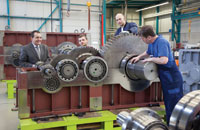
Posted to News on 27th Jul 2015, 00:00
Gearboxes selected for lock gates in Panama Canal upgrade
A massive upgrade on the Panama Canal to accommodate larger vessels has seen some 34 gearboxes specified for the lock gates.

>The $5.2 billion project to increase the capacity of the Panama Canal which includes the installation of a third set of lock gates is nearing completion. Being such an important trade route, it is essential that all of the components are designed and built to the highest standards. With the construction having started back in 2009, the expansion project is designed to double the capacity of the route by introducing a new transit lane that will allow larger ships to pass through the canal. In order to accommodate these larger vessels, it has been necessary to widen and deepen the existing channels and construct two new lock complexes.
>The design of the new locks has been carefully considered so as to minimise the resources required to operate them. This includes the use of water-saving basins that reduce the volume of water required to operate each lock and also help to minimise the salinisation of Gatun Lake which lies between the entry and exit points of the canal. The locks in the original canal use a more traditional mitre lock gate design whereas the new lock complex employs sliding doors that are housed in a recess in the lock wall. Each lock complex uses three chambers that are each enclosed by two pairs of steel doors to convey the ships between the level of the ocean and that of the Gatun Lake.
>The sliding doors are installed in pairs so that any maintenance that is required can be carried out in-situ, while still allowing vessels to transit through the lock complex. This has been made possible by designing the recess in the canal wall so that it can be sealed and the water pumped out to allow unhindered access to the steel door. A typical steel door measures 30m high by 10m wide and 58m long, weighing, on average, 3,400 tonnes. These doors enclose the chambers which measure 55m wide, 427m long and 18m deep, allowing the passage of larger vessels, the Post Panamax. Using the water in the water-saving basins allows the ships to be raised by 26m from the level of the ocean to that of the Gatun Lake.
>The contract to design and manufacture the steel doors was awarded to Cimolai Technology and it had the task of selecting the most suitable supplier for the power transmission system. The task of moving the 16 enormous doors was awarded to Brevini Power Transmissions, which has designed and manufactured 34 'Posired 2' helical gearboxes specifically for the project.
>The design required each steel gate to open in less than five minutes so that the time for a vessel to transit through the lock complex could be minimised. In all, the gates are expected to operate an opening/closing cycle up to 33 times every day. With the huge importance of this route comes the need for rock solid reliability and all of the gearboxes are required to perform for 35 years without failure, a total of over 47,000 working hours.
>"Excellence is the only way to acquire orders such as the Panama Canal that involve major world players and require advanced technologies," commented Roberto Cimolai, managing director of Cimolai Technology. "Investing in innovation is our path to growth. This strategy is valid especially for markets based on B2B engineering. We must always stay one step ahead of the competition. Also in the relationship with suppliers and partners, such as with Brevini, it is necessary to create a successful system based on first class brands with unparalleled products of quality."
>The 34 gearboxes were built in Germany by PIV, a subsidiary of Brevini Power Transmissions, having proven that it could deliver the reliability and durability in the required time frame. The double parallel shaft gearboxes, which measure over 2.5m in length, use helical gears with four reduction stages to deliver the required power to the lock gates.
>The Posired 2 gear units are designed to have a high degree of standardisation that delivers the optimum availability and short delivery times. The modular construction system allows bespoke gearboxes to be designed and manufactured using a robust design, while the gears are hardened using an in-house heat treatment facility to ensure continuous quality.
>With the new gearboxes in place and the expansion project looking to be completed by the middle of 2016, the outlook for an improved transit route through Panama is looking excellent. With the levels of high quality engineering and planning being used throughout the project, the new lock system should meet all expectations in the years to come.






